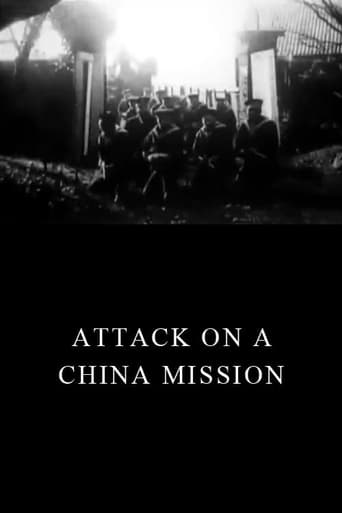He_who_lurks
This early Williamson film is, for its time, quite advanced as it displays a rather exciting drama (with some violence to boot!) and apparently uses 4 scenes. You don't see a lot of that in 1900 films! (The reason I say 'apparently' is because a fragment of Williamson's film survives. Actually two fragmented versions do: One shows the attack part while the other displays a fragment of each of the 4 scenes. The attack fragment is on Kino's "Movies Begin" set).I don't know much about the Boxer Rebellion, but it appears the film is about a missionary's home being attacked, but luckily some sailors (well, they looked like sailors!) come to rescue the home. There's shooting and bloodshed and several corpses lying around and for 1900 this one's quite sophisticated. Most films in 1900 were very dull and were only a minute; this short film originally ran 4 minutes, for its time that was long! If you want to see this one check out the version on YouTube, because that's the one that shows parts of all 4 scenes, so that one gives us an idea of how the original was.
MartinHafer
In the early days of the cinema, actual film of important historic events often wasn't available but the public clamored for news of the world. So, film companies began faking the news--making film of what people THOUGHT might be the actual events. A good example of this is the Edison film that purports to show the execution of the man that assassinated President McKinley. Another is this re-creation of this attack by Chinese peasants (the "Boxers") on a missionary and his family. Such attacks had happened, but given the sparsity of movie cameras, the scene was re-enacted for the public in this film. The problem is that the home and landscaping don't look particularly Chinese. Not a terrible film, but also not a particularly interesting or compelling one either.
Snow Leopard
In 1900, it would have been pretty ambitious to tell a fairly involved story like this in a short motion picture. It's hard to evaluate "Attack on a China Mission", in part because it tries to do more than it accomplishes, and in part because portions of the complete film seem not to have been preserved. (And what is preserved also shows definite signs of physical deterioration.)The story is set in the Boxer Rebellion, which would still have been fresh in the public's mind at the time this movie was made. Otherwise, it would be hard or impossible to determine the context of events or the motivations of the characters from the film alone. There is plenty of action, and some good camera shots of it as well, although the course of events is sometimes a little chaotic. Still, it does tell a complete story, as far as it goes.Given the limited resources and techniques then available, telling a story like this was an enterprising idea. Most of the other Williamson films of the era are of good quality, and it seems likely that this one might also have been a good one in its original or complete form. What survives of it is flawed, but still somewhat interesting.
Alice Liddel
This exciting action film offers a template for subsequent siege masterpieces, such as 'Rio Bravo' and 'Straw Dogs'. The narrative is beautifully simple and encapsulated in the title. In its steady focus on action, without reference to history, the film might seem to be ideologically free, abstracting the conflict (between colonists and Boxers) in the way Buster Keaton does in 'The General'. After all, its just one group attacking the other, we don't know the reasons or values of either's cause.The film is in fact heavily weighted in a way subsequently influential on Hollywood cinema as a whole. Although it doesn't indulge in the 'Yellow Peril' racism that would mar Hollywood in the forthcoming decades, the title suggests a point of view, an attack on a mission, something violent and destructive on something stable and Christian. The fact that it's a 'Chinese' mission suggests that the Chinese aggressors are in some way attacking themselves. A fairer, if less crowd-pleasing, title might have been 'Justifiable Revolt against White Imperialists'.Visually, the film bears this out. The missionaries are linked to the house, the solid, property, and to heterosexual normality (there are men and women); surrounded by trees and growth, they are natural, rooted, good bourgeois. The Boxers come from nowhere; they have no other purpose other than destruction; no family, religious or social ties; they hack down nature, or represent its more sinister manifestation, as their gun play creates gorgeous swirls of dust that obscure the peculiarly English country house.Of course, there is an ambiguity here that the action cinema has never really resolved - the need to assert conservative values conflicting with the need for action, destruction, violence, above all, change. The film only becomes exciting when the Boxers charge in; and when one of the dear old ladies runs comically screaming to an upstairs balcony, you wonder which side the director is actually on.
